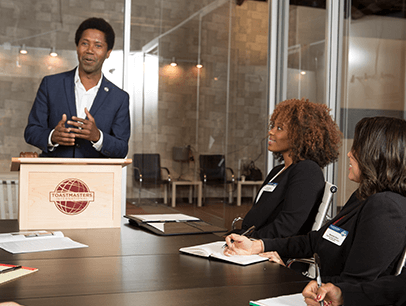
The commotion began while I was leading a workshop in a quiet neighborhood. Everyone was engaged until we heard a noisy disruption outside the window. My audience was clearly distracted, but I plodded on. They became more and more inattentive until I lost them entirely: They got up and left! Without a good reason to continue, I joined them.
Outside we saw a huge brown bull, bashing into the fence of the farm across the street. Eventually, he broke free and started trotting down the road, leaving his little calves running wildly inside their pen. Only when the farmer had the situation well under control were we able to go back in and continue.
I am not the only speaker who has tried to ignore unexpected events. Sometimes it’s easier to ignore a situation, knowing how hard it can be to get back on track after an interruption and how awkward it is to intervene if the distraction is coming from your audience. When giving a speech, I sometimes feel like I am on a train journey—I want to get to my destination smoothly, without a lot of jolts or stops. To pause unexpectedly is alarming: Will we be delayed? Will I get derailed? The less experience you have as a speaker, the more these distractions will unsettle you.
Ignore or resolve the situation?
One option is to ignore the situation and simply proceed with your talk. This passive approach works only if the interruption is not extreme or is over a short period of time. A small, flickering florescent light in the back of the room may drift into our unconscious. A 10-second fire truck siren is easily forgotten. But it’s different if the florescent light is large and right over your head or if the sirens go on and on.
Check in with your audience members to see if they are distracted by the events. Are they fidgeting, looking around, nudging each other, or whispering? If so, intervention is the best approach.
Once, I observed someone answer her cell phone and start a conversation in the middle of my presentation.
Sometimes you can just acknowledge the situation; other times you might need to act. A few years ago I was in the audience when the sound of vacuuming from outside the room suddenly made it hard to hear. The speaker looked at us, smiled, and said, “Well, I’m not going to talk over that.” And then he simply stopped talking. Someone went out to the hallway to ask the cleaning staff to vacuum elsewhere, and the presenter resumed his talk. His approach worked for him, but you could also be more direct and say, “I’m sorry, but that noise is just too loud for me to talk over. Can we do anything about it? Otherwise, maybe we should take a break.”
A few months ago, I was leading a workshop that included a video. I had set up my projector earlier, and it had seemed fine. But now the sunlight was streaming through a nearby window on to my projection, making it hard to see. I stopped my presentation, brought a chair over to the window and, with help from audience members, covered the offending window. Yes, my intervention caused several minutes of delay, but it also easily resolved the problem.
How to deal with people problems.
When the disturbance comes from audience members, it can be trickier. I’ve seen people talking, or moving about, or engaged with their devices. Once, I actually observed someone answer her cell phone and start a conversation in the middle of my presentation. If you encounter these behaviors, it’s best to simply say something. Be polite but direct: “I’m sorry, but I’m having trouble focusing while you’re chatting. Could you take your conversation to another room?”
If you’re speaking at a club event where you know everyone, it can be equally, if not more, uncomfortable to intervene. Toastmasters tend to be more sympathetic to speaker difficulties because, well, we’ve all been there. However, sometimes it feels awkward to intervene with someone you know. Years ago, one of our members would regularly interrupt speeches from the audience or hold side conversations during a speech; yet none of us ever knew what to say, so no one confronted her. I should have just said, “Joan, it seems like you have questions and comments to offer. It would be better for me if you could hold those until the end of my speech, thanks.” Just say it in a friendly way and with a smile.
It’s likely that if you’re distracted by something, your audience is as well. They came to hear what you have to say, and they deserve to hear it. It’s best to stop briefly, acknowledge the situation, and rectify the disturbance as promptly and effectively as you can. The first time might be intimidating, but it gets easier with time, and your audience will be grateful.
Understand some situations can’t be fixed.
Sometimes the issue may be truly beyond your control—particularly technology problems, room conditions, or outside noises. If your audience has noticed the problem, acknowledge it. Confusion is distracting, and affirming that something is happening will reassure and likely even relax them.
Toastmasters tend to be more sympathetic to speaker difficulties because, well, we’ve all been there.
Humor is always helpful. You could say, “I’m sure you have all noticed the temperature drop in here. Anyone have an extra pair of gloves? I can’t feel my fingers!” And then add, “Apparently, the problem is with the thermostat. If you need to take a break to warm up in the hallway, feel free to do so.” Audience members will appreciate your candor and most likely sympathize with your difficult position. You have not only acknowledged the situation but given them a short-term solution.
The bull-outside-the-window event is an example of a situation that was out of my control. Instead of ignoring it, I could have stopped my presentation much sooner and said, “Wow, what is that commotion? It’s too loud for me to continue! Maybe we should take a break and go see what’s happening.”
Be positive.
Whatever happens, it’s important to display a positive attitude. Act confidently and poised even if you don’t feel that way. It’s okay to fake it. Acting composed in the face of chaos helps you feel calm and reassures the audience that you are in charge and able to deal with the situation.
Whether you are asking for assistance with the audiovisuals or confronting a rude audience member, do it with a smile. Remember, the audience is on your side; they came to hear what you have to say.
As Toastmasters, we’re fortunate to be able to practice interruptions and learn how we handle them best. Before you give a presentation, ask a member to create a distraction and then try to handle it and continue your speech. The more experience you have dealing with disruptions, the easier it will be to face them without getting derailed.
We cannot totally avoid unexpected events. But we can tackle them with confidence and poise. Take the time to make it right. Your audience deserves nothing less.
Watch the video below for extra tips to help you stay on topic and not get sidetracked.
Barbara Augello is a longtime Toastmaster and member of the South Shore Soliloquy club in Kingston, Massachusetts, United States. She is a freelance writer and owner/operator of Health Ed of New England.



 Previous
Previous
 Previous Article
Previous Article

